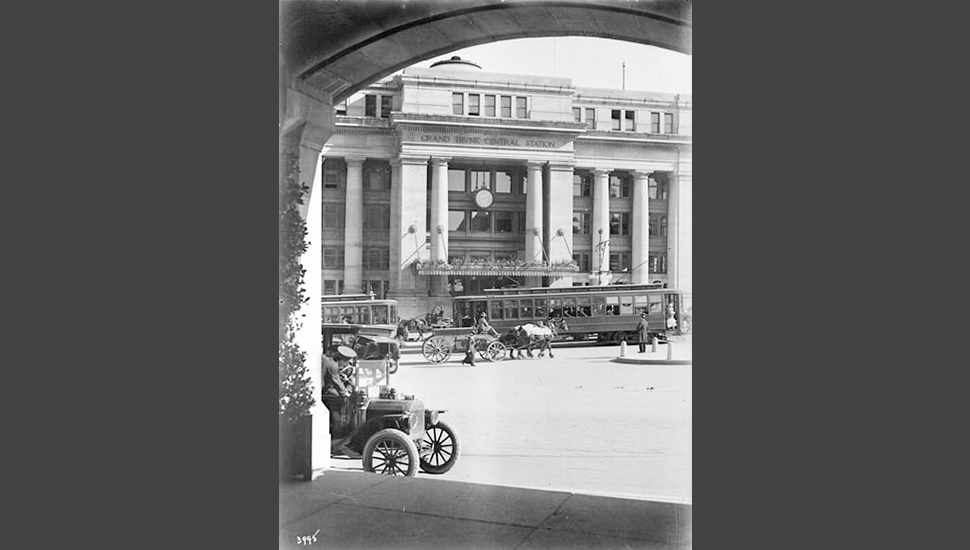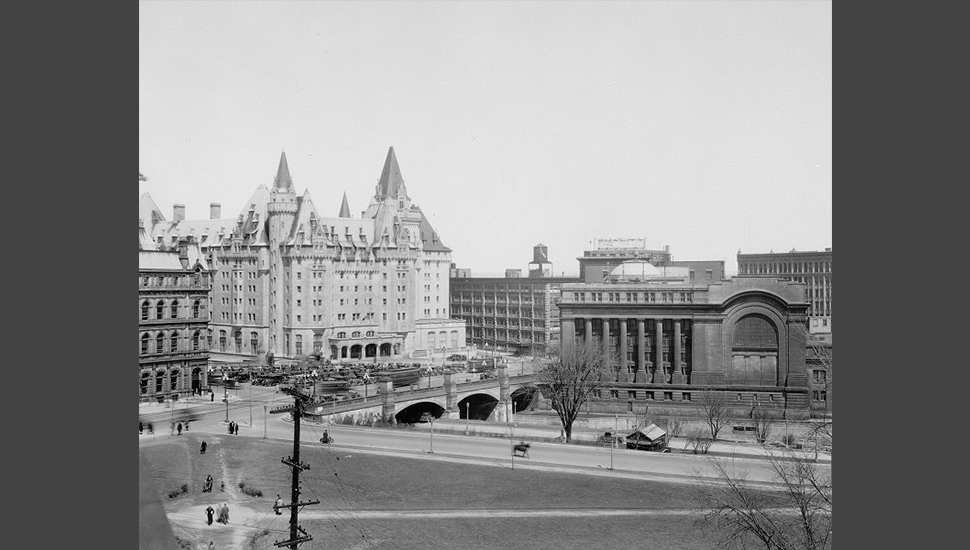CONSTRUCTED: 1909 to 1912
ARCHITECTS: Ross & MacFarlane, Montreal
LOCATION: 2 Rideau Street, Ottawa
The former Union Station building, initially known as Grand Trunk Central Station, was designed by Montreal-based architecture firm Ross & MacFarlane. The firm's Beaux- Arts concept was praised as "strikingly beautiful" by city council and newspaper reporters of the day. Hallmarks of the Beaux-Arts style are evident in the building's theatrical, monumental and self-confident use of classical forms such as the columns, entablatures, pilasters, domes and arches.
Union Station was built to serve as Ottawa's central railway station. It was constructed on the site of the old Central Railway Depot, built in 1896 by the Canada Atlantic Railway established some eighteen years earlier by Canadian lumber baron John R. Booth.
Construction of the new station began in July 1909. After multiple delays the station finally opened to the public in June 1912.
The Château Laurier Hotel, constructed during the same time frame and located across the street, opened on the same day. The Hotel and Station were connected by a tunnel.
The threat to the Union Station building began in the late 1940s when “The Greber Plan" recommended removal of the railways from central Ottawa in favour of a scenic driveway. To this end, the National Capital Commission (NCC) entered into an agreement with the railway companies on December 1, 1959 to construct a new railway station southeast of the core in the Hurdman’s Bridge area, in exchange for Union Station.
Union Station ceased operations as a passenger train facility in 1966. When intentions to demolish Union Station became apparent — to create parking for visitors during the 1967 centennial — voices rose in objection.
The Roots of Heritage Ottawa
A strong public argument for the preservation of Ottawa's architectural heritage — and the preservation of Union Station in particular — was made by Constance Wright on behalf of the Centennial Beautification of Ottawa Committee. Published in The Ottawa Journal on March 5, 1966, her words inspired others to join in opposition against the impending demolition of Union Station.
In response to the protest, a one-year reprieve for the Union Station building was announced on July 14, 1966 by George McIlraith, Minister of Public Works.
In 1967, the Centennial Beautification Committee became "A Capital for Canadians", and Mary Anne Phillips established its heritage committee that would become Heritage Ottawa.
Union Station served as a Visitors Centre throughout the 1967 Centennial celebrations. On September 2, 1969 it was announced that the building would be converted to a Government Conference Centre.
R.A.J. (Bob) Phillips, original founding member and past president of Heritage Ottawa, summarized the battle to save Union Station in the December 1981 issue of Ottawa Magazine:
"In 1966 the last train pulled out of Union Station because the sordid freight yards crowding the Rideau Canal were to become parklands for people to enjoy. There remained the noble pile built in 1912 to be a sort of cathedral in an age when railways were religion. It was modeled on the Roman baths of Caracalla to soar above the ordinary, to lift the spirit, to praise the steam train. What would happen to it?
Government planners had settled that question. It was to be bulldozed into dust to make a parking lot for buses bringing tourists to Centennial celebrations. Some public-spirited Ottawans, notably the Committee for the Beautification of Ottawa, thought that was a curious way to celebrate the Centennial. They wrote letters, bullied editors, got on radio and television and chased politicians down the corridors of power. A year’s reprieve was given to allow the VNION STATION (as the name was carved in stone) to be a Centennial centre for 1967. When the idea of a National Conference Centre followed, the building was saved. (We also saved a few million tax dollars by renovating instead of building anew)."
Thanks to the pioneering advocacy efforts of our founders, Union Station was the first of many significant heritage buildings to be saved with the help of the committee that would become Heritage Ottawa.
Union Station was recognized as a Classified Federal Heritage Building in January 1989 for its historical associations, architectural value, and landmark status in Ottawa and the surrounding region. Union Station was listed on the Canadian Register of Historic Places in January 2006.
The former Union Station | Government Conference Centre is currently undergoing extensive restoration and rehabilitation work in preparation for its next purpose as interim home to the Senate of Canada while the Centre Block of Parliament undergoes major rehabilitation work.
UPDATE | October 2018: CLICK HERE to see Union Station's most recent transformation to the new home of the Senate of Canada.
UPDATE | March 2019: Take a GUIDED TOUR of the magnificently restored, newly renamed Senate of Canada Building—Ottawa's former Union Station! CLICK HERE to reserve free tickets.
UPDATE | May 2019: Former Union Station is New Senate of Canada | Heritage Ottawa Newsletter, by Carolyn Quinn
UPDATE | October 2021: Senate of Canada Building Wins Top Honours at 2021 International Architecture Awards | Special to The Globe and Mail, by Wallace Immen












